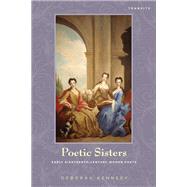Poetic Sisters Early Eighteenth-Century Women Poets
, by Kennedy, Deborah- ISBN: 9781611484854 | 1611484855
- Cover: Hardcover
- Copyright: 12/14/2012
In the early eighteenth century an unprecedented number of women began to write and publish poetry. They reflected on what it meant to be a poet, and they often found a collective strength in their relationships to other women writers. Poetic Sisters concentrates on the work of five representative poets: (1) Anne Finch, Countess of Winchilsea (1661-1720); (2) Elizabeth Singer Rowe (1674-1737); (3) Frances Seymour, Countess of Hertford (1699-1754); (4) Sarah Dixon (1671-1765); and (5) Mary Jones (1707-1778). There are numerous personal and literary connections among these five talented writers. They wrote in a variety of genres and on a diverse array of topics, from serious religious poems to amusing verses on domestic life. Of the five women, Anne Finch is the best known, and her work provides a cornerstone for the book. But it was Elizabeth Rowe who achieved international fame in her own day. She was a type of literary star, known for her popular religious poetry and prose. The Countess of Hertford, born at Longleat, wrote about her love of nature centuries before the Earth Day celebrations of today. Sarah Dixon, a middle-class writer from Kent, had a strong moral outlook and stood up for those whose voices needed hearing, including her own. Mary Jones, who lived in Oxford, was praised for both her genius and her sense of humour.By studying these writers in context, the book makes an important contribution to feminist literary history. In addition, it establishes connections between the eighteenth century and the present day. The concluding chapter explores the question of the poets' literary afterlife, showing how they have been recuperated for the classroom and for the general public and how they have found a place in the contemporary cultural scene. This engaging book brings the eighteenth century back to life and reveals the bonds of a shared vocation that unites these poetic sisters.






